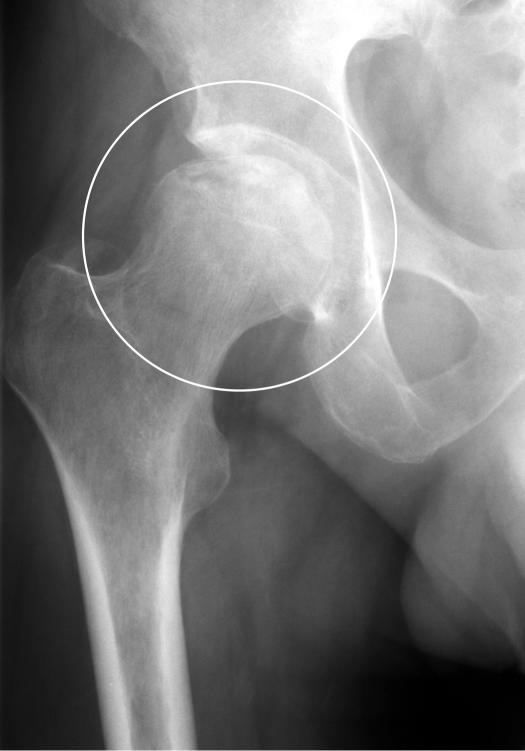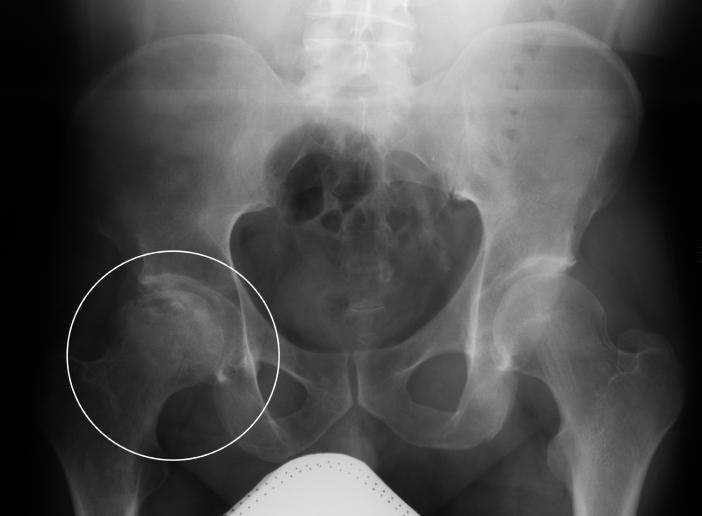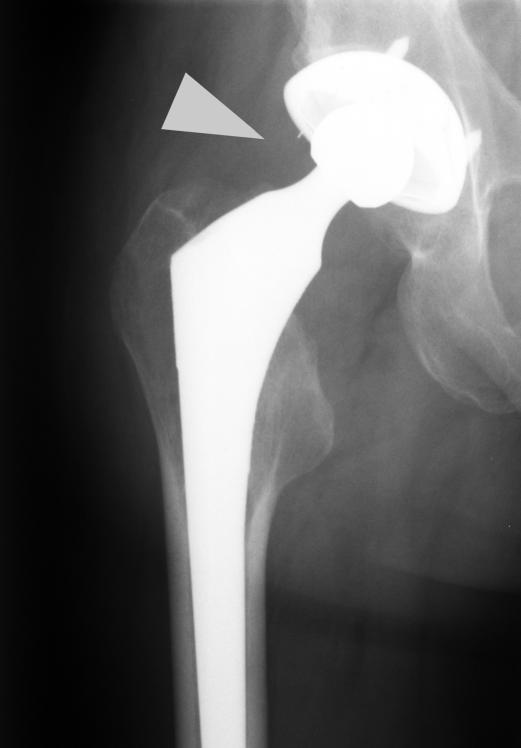Abstract
This case deals with the avascular necrosis or osteonecrosis of the femoral head in a 41-year-old male presenting to a chiropractor’s office. In addition to the clinical picture, diagnostic imaging should be performed to confirm the presence and extent of hip avascular necrosis. Referral to an orthopedic specialist is key and treatment is mainly surgical.
Keywords: avascular necrosis, total hip arthroplasty, rehabilitation, osteonecrosis, chiropractic, hip pain
Abstract
Ce cas traite de la nécrose avasculaire ou de l’ostéonécrose de la tête fémorale chez un homme de 41 ans se présentant dans un bureau de chiropraticien. En plus de dresser un portrait clinique, il est nécessaire d’effectuer une imagerie diagnostique afin de confirmer la présence et l’ampleur de la nécrose avasculaire de la hanche. Il est primordial d’aiguiller le patient chez un orthopédiste et le traitement est principalement chirurgical.
Case report
A 41-year-old male presented to a chiropractor’s office for ongoing right sided low back, hip and knee pain for the past six months following jumping off a two meter high roof and landing on his feet. He had immigrated to Canada from abroad two months prior to consulting us. The patient had an antalgic limp and walked with the help of a cane. He complained of intermittent pain radiating into his right groin and anteriomedial thigh region. He stated that his symptoms were aggravated by walking and stair climbing. His pain was relieved by sitting and resting. The patient did not report numbness or paresthesias in his lower extremities. There was no bowel and bladder dysfunction. The patient did not complain of any night sweats, fever or chills.
The patient had previously sought medical advice and was prescribed pain killers and antiinflammatories. At that time, he had radiographs of his lumbar spine done which he stated were normal. He then saw a chiropractor for approximately one month with no improvement. Subsequently he had a lumbar spine MRI done and was referred to a neurosurgeon for consult. The MRI showed a small disc bulge in the T12/L1 region. The neurosurgeon’s report stated that he was unable to correlate the patient symptoms with the MRI findings and recommended EMG studies. He then moved to Canada and presented to our office for continuing management.
Past history revealed that the patient received a flu vaccine 14 months prior to injury. He subsequently developed an allergic reaction and was diagnosed with leukocytoclastic vasculitis skin eruptions. This was treated with four months of oral corticosteroid therapy with doses up to 50 mg per day. The skin lesions resolved with treatment. However he developed corticosteroid-induced glucose intolerance subsequent to treatment. Past history also revealed a nasal fracture six years ago which required two surgical interventions. The patient stated he does not drink or smoke currently and has not in the past. The patient stated that he does not have any night pain. In addition, he reported that he has had no noticeable weight change in the past year. He stated that he has not worked since his injury.
On physical examination, range of motion of the right hip was severely limited and painful in all ranges, with most pain being felt in abduction and internal rotation. Palpation of the right hip region revealed extreme tenderness. Muscle palpation revealed tenderness in the right thigh and pelvic musculature. Muscle atrophy was also noted in the right thigh musculature. Lumbar spine range of motion was full with end range pain in right lateral flexion and right rotation. Valsalva was unremarkable. Straight leg raise produced right hip pain. Posterior joint provocation tests were painful for L4, L5. SI testing was painful for the right sacroiliac joint. Muscle palpation revealed tenderness in the lumbar paraspinal and right gluteal musculature. Range of motion of the right knee was full and pain free and no effusion was noted. Muscle palpation revealed tenderness in the right TFL and quadriceps musculature. Lower limb neurological testing revealed normal reflexes and sensory testing bilaterally. Global muscle weakness was noted in the right lower limb when compared to the left.
Impression
The patient was suspected as having avascular necrosis of the right hip with differential diagnoses of hip osteoarthritis or healed fracture. He was referred to a medical radiology facility for radiographs of the lumbar spine, right hip and pelvis. The radiology report stated that there was marked irregularity to the right femoral head with sclerosis, subchondral lucency and mild collapse. This report led to the diagnosis of avascular necrosis of the right hip. The patient was also diagnosed clinically as having lumbosacral and sacroiliac strain/strain. Based on the radiology report, the patient was immediately referred to an orthopedic surgeon for consult and advice. The patient was soon scheduled for right hip replacement surgery. Figures 1 (AP–right hip) and 2 (AP–pelvis) are x-rays taken prior to the surgery. Figures 1 and 2 both show presence of patchy luceny and sclerosis in the right femoral head region with some collapse and irregularity of the articular cortex demonstrating a subchondral stress fracture. Figure 2 also compares the right and the left hip joints. The left hip joint is normal.
Figure 1.
AP-right hip with avascular necrosis.
Figure 2.
AP-pelvis with comparison of right and left hip joints.
Clinical course post-operatively
A cementless total hip replacement or arthroplasty was performed. Following surgery, the patient was monitored with periodic follow-ups while undergoing post-surgical rehabilitation. This initially consisted of passive stretching of the hamstrings, quadriceps, hip flexors and abductors, as well as passive and active range of motion exercises for the hip and knee. A number of strengthening exercises were slowly incorporated to strengthen primarily the quadriceps, hip abductors and hamstrings musculature using a pulley system and ankle weights. Once the patient was able to weight-bear, he was instructed in restoring normal gait. The patient was then progressed to closed kinetic chain strengthening, balance and proprioceptive exercises including the use of a wobble board to restore muscle and joint coordination and position sense. In addition, cardiovascular conditioning was incorporated by having the patient use a stationary bike. The patient attended the post surgical rehabilitation facility for about seven months with decreasing frequency and then was discharged with an independent home exercise program. At this time, the patient had satisfactory right hip range of motion with a small trunk lurch to the right. The patient reported that his right hip pain had significantly reduced and he had returned back to work when he was followed up at the time of discharge.
Postsurgical radiographs ordered by the orthopedic surgeon of the right hip showed the presence of an uncemented right total hip prosthesis in good alignment. (Figure 3 – AP right hip).
Figure 3.
AP-right hip with uncemented total hip prosthesis.
Discussion
Avascular necrosis is characterized by osseous cell death due to vascular compromise.1 Avascular necrosis of bone results generally from corticosteroid use, trauma, SLE, pancreatitis, alcoholism, gout, radiation, sickle cell disease, infiltrative diseases (e.g. Gaucher’s disease), and Caisson disease.1,2 The most commonly affected site is the femoral head and patient’s usually present with hip and referred knee pain.1,2 This patient presented with avascular necrosis of the right hip with pain referred to the right knee. The possible causes in this case were corticosteroid use after the subsequent allergic reaction to the flu vaccination and trauma due to the fall. It appears that his avascular necrosis may have been initially overlooked.
Radiological features of osteonecrosis generally involve collapse of the articular cortex, fragmentation, mottled trabecular pattern, sclerosis, subchondral cysts, and/or subchondral fracture.1 This patient's radiographs (Figure 1 and 2) demonstrated the presence of extensive osteonecrosis of the right hip. A bone-scan or MRI could also be used to confirm the presence and extent of avascular necrosis.
Treatment is mainly surgical and generally involves a total hip replacement or arthroplasty for end-stage femoral head osteonecrosis3 using either a cemented or cementless prosthesis. Cemented total hip arthroplasties have been reported as being inferior with high failure rates in younger patients and in patients with femoral head necrosis because of their inferior durability.3–9 Improved outcomes have been reported with cementless total hip arthroplasties for patients with femoral head osteonecrosis.3,10,11 In this case, the surgeon performed a cementless total hip arthroplasty.
Rehabilitation treatment protocols vary widely after total joint replacement.12 There are very few controlled trials available on the effects of different exercise programs after total joint arthroplasty.12 It has also been suggested that a presurgical exercise program may be beneficial in increasing the rate of improvement in patient recovery after a total hip replacement.13,14 Early mobilization is the gold standard in restoring functional mobility after total joint arthroplasty.12 The goal of rehabilitation is to increase muscle strength/endurance, improve coordination, increase flexibility, increase aerobic capacity and promote tissue remodeling.15 In this case the patient underwent a comprehensive postsurgical rehabilitation program to improve his functional ability.
The use of a cementless femoral component in total hip arthroplasty is in its second decade and therefore there are only a few studies published describing a ten year followup.16 Followups have been reported in the literature at an average of 5–7 years.16,17 The major concerns regarding cementless total hip arthroplasty have been thigh pain, osteolysis and long term stability.16 Chiu states that the incidence of thigh pain might be related to a poor fit of the femoral stem.17 Revision rates for cementless techniques are lower than for cemented techniques.17–21 More studies are needed to address the long term prognosis of hip arthroplasties in younger adults. Considering the age of this patient, periodic follow-ups with an orthopedic specialist are essential in helping monitor the integrity of the surgical procedure.
Conclusion
Whenever a patient presents with hip pain secondary to trauma and/or corticosteroid use, the clinician must include avascular necrosis as a differential. The diagnosis is confirmed by imaging procedures. The chiropractor should refer the patient to a physician or specialist if there is radiological evidence of avascular or osteonecrosis of the hip.
References
- 1.Yochum T, Rowe L. Essentials of skeletal radiology. 2nd ed. Baltimore: Williams & Wilkins 1996; 1260–1263.
- 2.Tierney Jr. LM, McPhee SJ, Papadakis MA. Current Medical diagnosis and treatment. 36th ed. Stamford: Appleton & Lange 1997; 798–799.
- 3.Fye MA, Huo MH, Zatorski LE, Keggi KJ. Total hip arthroplasty performed without cement in patients with femoral head osteonecrosis who are less than 50 years old. J Arthroplasty. 1998;13:876–881. doi: 10.1016/s0883-5403(98)90193-0. [DOI] [PubMed] [Google Scholar]
- 4.Callaghan JJ. Results of primary total hip arthroplasty in young patients. J Bone Joint Surg Am. 1993;75:1728. [Google Scholar]
- 5.Chandler HP, Reineck FT, Klixson RL, McCarthy JC. Total hip replacement in patients younger than 30 years old. J Bone Joint Surg Am. 1981;63:1426. [PubMed] [Google Scholar]
- 6.Devlin VJ, Einhorn TA, Gordon SL, et al. Total hip arthroplasty after renal transplantation: Long-term follow-up stuffy and assessment of metabolic bone status. J Arthroplasty. 1988;3:205. [PubMed] [Google Scholar]
- 7.Dorr LD, Takel GL, Conaty JP. Total hip arthroplasty in patients less than 45 years old. J Bone Joint Surg Am. 1983;65:474. [PubMed] [Google Scholar]
- 8.Saito S, Saito M, Nishina T, et al. Long-term results of total hip arthroplasty for osteonecrosis of the femoral head: A comparison with osteoarthritis. Clin Orthop. 1989;244:198. [PubMed] [Google Scholar]
- 9.Salvati EA, Cornell CN. Long-term follow-up of total hip replacement in patients with avascular necrosis. AAOS Instr Course Lec. 1988;37:67. [PubMed] [Google Scholar]
- 10.Piston RW, Engh CA, Carvalho PI, Suthers K. Osteonecrosis of the femoral head treated with total hip arthroplasty without cement. J Bone Joint Surg Am. 1994;76:202. doi: 10.2106/00004623-199402000-00006. [DOI] [PubMed] [Google Scholar]
- 11.Phillips FM, Pottenger LA, Finn HA, Vandermolen J. Cementless total hip arthroplasty in patients with steroid-induced avascular necrosis of the hip. Clin Orhop. 1994;303:147. [PubMed] [Google Scholar]
- 12.Roos EW. Effectiveness and practice variation of rehabilitation after joint replacement. Curr Opin Rheumatol. 2003;15:160–162. doi: 10.1097/00002281-200303000-00014. [DOI] [PubMed] [Google Scholar]
- 13.Gilbry HJ, Ackland RR, Wang AW, Morton AR, Trouchet T, Tapper J. Exercise improves early functional recovery after total hip arthroplasty. Clin Orthop. 2003;408:193–200. doi: 10.1097/00003086-200303000-00025. [DOI] [PubMed] [Google Scholar]
- 14.Wang AW, Gilbey HJ, Ackland TR. Perioperative exercise programs improve early return of ambulatory function after total hip arthroplasty. Am J Phys Med Rehabil. 2002;81:801–806. doi: 10.1097/00002060-200211000-00001. [DOI] [PubMed] [Google Scholar]
- 15.Liebensen C. Rehabilitation of the spine. Baltimore: Williams & Wilkins 1996; 31–34.
- 16.Hellman EJ, Capello WN, Feinberg JR. Omnifit Cementless total hip arthroplasty. Clin Orthop. 1999;364:164–174. doi: 10.1097/00003086-199907000-00022. [DOI] [PubMed] [Google Scholar]
- 17.Chiu KH, Shen WY, Ko CK, Chan KM. Osteonecrosis of the femoral head treated with cementless total hip arthroplasty. J Arthroplasty. 1997;12:683–688. doi: 10.1016/s0883-5403(97)90142-x. [DOI] [PubMed] [Google Scholar]
- 18.Brinker MR, Rosenbery AG, Kull L, Galante JO. Primary total hip arthroplasty using noncemented porous-coated femoral components in patients with osteonecrosis of the femoral head. J Arthroplastry. 1994;9:457. doi: 10.1016/0883-5403(94)90091-4. [DOI] [PubMed] [Google Scholar]
- 19.Kim YH, Oh JH, Oh SH. Cementless total hip arthroplasty in patients with osteonecrosis of the femoral head. Clin Orthop. 1995;320:73. [PubMed] [Google Scholar]
- 20.Piston RW, Engh CA, Carvalho PL, Suthers K. Osteonecrosis of the femoral head treated with total hip arthroplasty without cement. J Bone Joint Surg. 1994;76A:22. doi: 10.2106/00004623-199402000-00006. [DOI] [PubMed] [Google Scholar]
- 21.Phillips FM, Pottenger LA, Finn HA, Vandermolen J. Cementless total hip arthroplasty in patients with steroid-induced avascular necrosis of the hip: a 62-month follow-up study. Clin Orthop. 1994;303:147. [PubMed] [Google Scholar]





